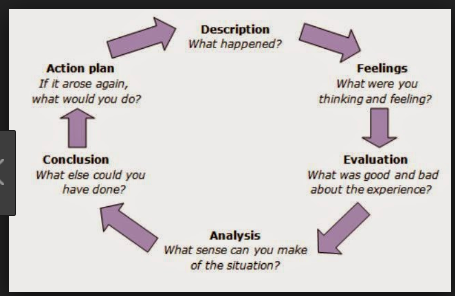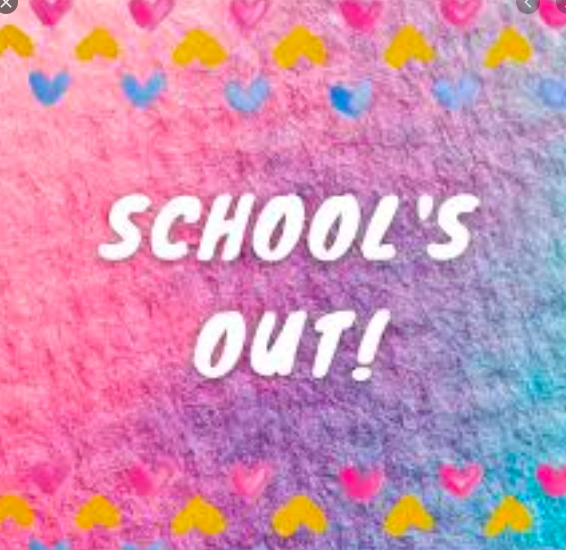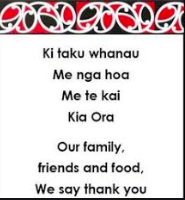7C2 Global Studies
Section outline
-
Kia ora...students and huge welcome to Coast whanua. My name is Mrs Ulika Singh and am you Global Studies teacher for this year.I hope you had a wonderful summer break and ready to venture with your learning at school.Our learning context is
He waka eke noa - strength of group enhances individuality / the most important thing in life is the connections we make with others. With this, we will examine who we are are/ where we come from/ the values we share that connect us to each other to build relations as well as identify skills we have or can learn to make new connections in our environment.

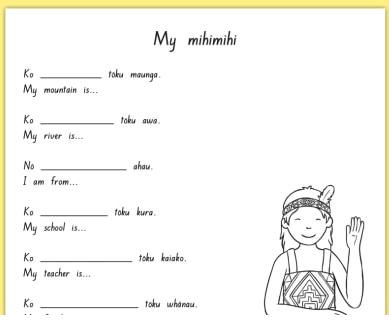
Achievement Objectives:
L3 Understand how the movement of people affects cultural diversity and interaction in New Zealand.L4 Understand how people pass on and sustain culture and heritage for different reasons and that this has consequences for people.
Success Criteria: I can/have...
- Understood our learning context by making links to ourselves/ friends and community
- Understood my immigration story and pepeha by creating a visual that describes me
Activities:
1) Let us brains storm our learning context and come up with ideas that link with us and our community eg: We are all in this together as it is our first day at school? Discus our excitement/ fears/ expectations and values we share!
2) Write down what are you most important values and skills.Let us also examine the meaning of ket words like respect/ religion/ culture/ traditions/ heritage/ immigration/ changes and adaptation
3)Reflect on your immigration story you had researched and discussed in week one. Did you or you parents immigrate from another country? Why did you leave? What re the various values and practices of of culture you were exposed too from your birth country or parents birth country? Is it different or similar to the values of living in New Zealand.
4) Think of all the values you consider as an import part of who you are are that has been shown and taught to you by your family, community and school. Using the information draw a plan of the different symbols, images, colours, flags, that make up your unique identity.
5) Think of a way you would like to showcase your cultural identity . For an example, design a digital papehe from your culture tat show your cultural side vs your Kiwiana side. Or perhaps it is integration of both your culture and new adopted Kiwi culture embodied as one. May be you only share one side of a culture than the other.
4) This can be created in various ways e.g.: The face mask or a bandana. However, I will allow your to express your cultural identity using any model or visual you like.Watch this for support:
5) Once you have completed this, share your pepeha with the class.
6) See images on the white board n cultural expressions: e.g.: flags, music instruments, cultural food, important traditional clothing, religious symbols, clots, phrases, dance form, values: respect, compassion, care, support and understanding.
Homework
Resources:
Mihi - introductions, Māori ki Te Whare Wānanga o Ōtākou ...
Sep 14, 2018 - Uploaded by Pepeha New ZealandPepeha is a way of introducing yourself in Māori. It tells a story of the places and people youPersonal beliefs, values, attitudes and behaviour | IAA
https://www.iaa.govt.nz › ... › Personal beliefs, values, attitudes and behaviourCultural identity Facts for Kids - Kiddle encyclop
EXPLORE / TŪHURA learning intentions:
- We are EXPLORING...to investigate students personalised immigration story and the vocabulary associated with this idea
- We are EXPLORING...to research the Treaty of Waitangi and its significance for us today in NZ
- We are EXPLORING...to discover the skills required to camp and research information on Camp Adair
-
Kia ora...students and welcome to week 2. For this week we will examine the treaty of Waitangi and explore how our values may link to the treaty.
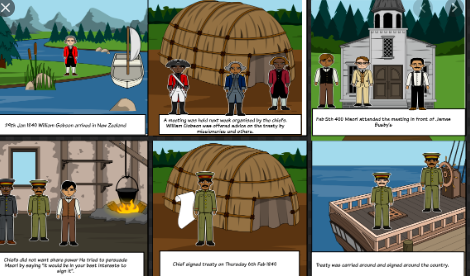
Success Criteria: I can/have...
- Researched the cultural identity of Maori and British cultures from the past to the present
- creatively design a digital story board that explore s early settlers and the Treaty of Waitangi and shows my values that connect with the Treay
Activities:
- Watch video on Early Maori cultures in NZ and answer the following questions; When did Maori people arrive in NZ and from which locations in the world.How did they arrive here. Describe the waka. Discuss the types of tribes found at that time and where did they settle. Discuss the foods Maori eat and how they collected as well as prepared traditional foods. Show the cultural dress/ music/ art and dance that is symbolic to them. What are the languages spoken.
- Examine the conflict between British and Maori people.Also explain with images the meaning of the treaty of Waitaingi.
- Do you think Maori cultures identity today is the same from few hundred years ago. Explain. Also show how the "west has influenced local Maori Identity.
- how does this treaty have greater significance to our multi- cultural society today. Think of values and connect your reasons to this.This must be explored in good detail.
- Indicate your information on a story board. See example in the classroom.
Resources:
The Maori - New Zealand in History
history-nz.org/maori.htmlwww.canva.com › create › storyboardsFree Online Storyboard Maker: Design a Custom Storyboard ...
EXPLORE / TŪHURA learning intentions:
- We are EXPLORING...to investigate students personalised immigration story and the vocabulary associated with this idea
- We are EXPLORING...to research the Treaty of Waitangi and its significance for us today in NZ
- We are EXPLORING...to discover the skills required to camp and research information on Camp Adair
-
Kia ora...students. This week will complete your research on the Treaty and its relevance today in our multicultural society. Also create your own Treaty and share with the class.This can be added to your storyboard created last week.
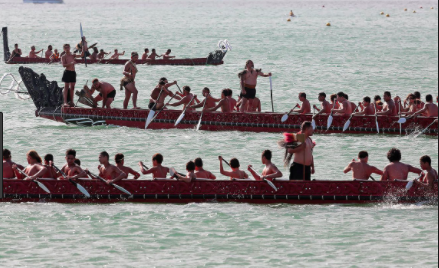
Success Criteria: I can/have...
- Researched the cultural identity of Maori and British cultures from the past to the present
- creatively design our project boards
Activities:
- Watch video on Early Maori cultures in NZ and answer the following questions; When did Maori people arrive in NZ and from which locations in the world.How did they arrive here. Describe the waka. Discuss the types of tribes found at that time and where did they settle. Discuss the foods Maori eat and how they collected as well as prepared traditional foods. Show the cultural dress/ music/ art and dance that is symbolic to them. What are the languages spoken.
- Examine the conflict between British and Maori people.Also explain with images the meaning of the treaty of Waitaingi.
- Do you think Maori cultures identity today is the same from few hundred years ago. Explain. Also show how the "west has influenced local Maori Identity.
- how does this treaty have greater significance to our multi- cultural society today. Think of values and connect your reasons to this.
- Complete the design of your own Treaty showing the values and ethics. This can be added to your storyboard created last week.
Resources:
The Maori - New Zealand in History
history-nz.org/maori.htmlEarly settlement - The arrival of Maori - NewZealand.com
Maori Foods & Recipes | Resources | New Zealand Now
https://www.newzealandnow.govt.nz/resources/maori-foods-and-recipesMāori clothing and adornment – kākahu Māori – Te Ara Encyclopedia ...
www.teara.govt.nz/en/maori-clothing-and-adornment-kakahu-maoriNgāpuhi war canoe at Waitangi | NZHistory, New Zealand history online
FOCUS / ARONGA learning intentions:
- We are FOCUSING...on developing our knowledge on the Treaty of Waitangi
- We are FOCUSING...on identifying the values and cultural beliefs of Maori cultures and see links to our own cultures
- We are FOCUSING...on developing our values and skills required for camp such as team work/ friendships / leadership/ compassion/ respect/ understanding/ time management/ responsibility
-
Kia ora...students and welcome to week 4. For this week you will be researching the location/ geography and activities of your camp site, Camp Adair.
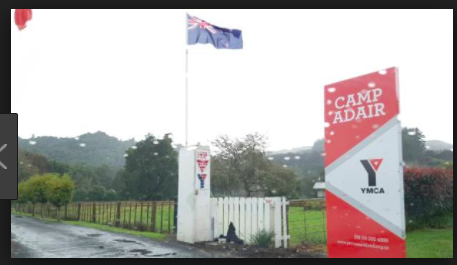
Learning Intentions: We are learning to (WALT)...
- Calculate distance from MHJC to Camp Adair
- Use google maps to show location and geographical features
- Understand the flaura and fauna here
- Investigate the rules and expectations whilst on site.
- Research the various activities you will be involved with
- Explore key values and skills you should display camp.
Success Criteria: I can/have..
Examined in detail the key information about my camp site, camp Adair.
Activities:
Why do you think attending camp is important. What are the skills you have that would be beneficial to you by attending camp. What skills do you think you will be exposed to that are new that would be important life skills. Describe these skills in detail.
Researching our Camp Location: Create a visual that has the following information.
MAP and Distance from MHJC: AREA AND ON SITE
HISTORY
CULTURES
DIVERSITY: FALURA AND FAUNA
FACILITIES
ACTIVITIES
EMERGENCY PROCEDURES
3) See video on students that have attended camp. what are your views.- What is meant by values and skills. Create a list of what values and skills you have that will be necessary to display and use effectively at camp e.g.: ability to listen well and lend a helping hand. Or the skills of biking and supporting people who are not good bikers. Also think of what skills you with like to develop whist you are at camp.
- Create a badge or a certificate that showcases you have attained the important skills for attending camp.
- Create a fun menu that you think would be ideal for camp. Use Canva to create a breakfast/ lunch and dinner option.
- Homework:
- Work on your Assessment task: Creating your Infographic:
Task Instructions:1)You will work in a team of 3 or 4 students
2) Read the resources on MHJC online, as well as additional materials you may find.Also see resources on how to create an infographic.
3) Create a plan before you begin writing.
4) Select two ideas that you want to research in detail eg: Housing/ transportation/ Schools, shopping/ farming.
4) Your infographic should have the following ideas: Introduction, History, changes today, Reasons for changes, Our Views and Conclusion.
5) Must submit as a printed visual on the due date.
FOCUS / ARONGA learning intentions:
- We are FOCUSING...on developing our knowledge on the Treaty of Waitangi
- We are FOCUSING...on identifying the values and cultural beliefs of Maori cultures and see links to our own cultures
- We are FOCUSING...on developing our values and skills required for camp such as team work/ friendships / leadership/ compassion/ respect/ understanding/ time management/ responsibility
-
Kia Ora Students
There will be No Global Studies this week as you are attending camp!
However, you will need to write a review about your camp experience.Be sure to have photos and showcase your strengths with leadership/ friendship/ problem solving and collaboration.
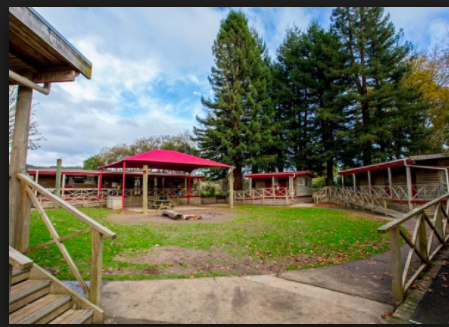
Task Instructions:1)You will work in a team of 3 or 4 students
2) Read the resources on MHJC online, as well as additional materials you may find.Also see resources on how to create an infographic.
3) Create a plan before you begin writing.
4) Select two ideas that you want to research in detail eg: Housing/ transportation/ Schools, shopping/ farming.
4) Your infographic should have the following ideas: Introduction, History, changes today, Reasons for changes, Our Views and Conclusion.
5) Must submit as a printed visual on the due date.
-
Kia ora...students and welcome to week 6. This week you will write a review snd reflection based on your Camp experience.Also you will create a marketing tool to promote attending camp to future year &'s students at MHJC.
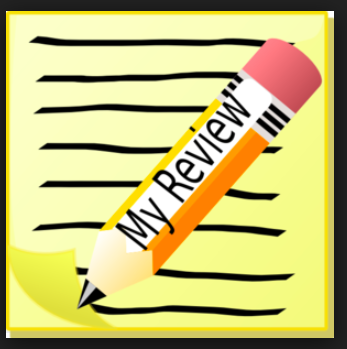
Learning Intentions: We are learning to (WALT)...
- Reflect on our positive experience and well as challenges at camp Adair
- use photographs( if any) to document your experience
- Critically apply ways to overcome the challenges you face
- Create a poster to market Camp Adair to future year 7 students
- Success Criteria: I can/have...
- Written a review on my camp experience and created a marketing tag to promote this site/experience
- Learnt and understood Maori words that link to our values
Activities:
- What are the benefits of attending camp. What skills have your learnt and shred with others.
- Discuss the challenges you have been through and how you may have overcome these.
- Explain using instructional writing techniques one activity you participated with that you enjoyed
- By using this template: reflect on your camp experience and write a review: Location/ Team members/ Leaders/ Positive experiences/ Challenges/ Overcome Challenges
- Do you think this experience has enabled you to grow and become more involved with other students
- Create a Maori words and phrases that link with our key values of respect/ compassion. friendship.
- Resources:
www.lucidpress.com › blog › 6-essential-elements-graphic-design-pos..FOCUS / ARONGA learning intentions:
- We are FOCUSING...on developing our knowledge on the Treaty of Waitangi
- We are FOCUSING...on identifying the values and cultural beliefs of Maori cultures and see links to our own cultures
- We are FOCUSING...on developing our values and skills required for camp such as team work/ friendships / leadership/ compassion/ respect/ understanding/ time management/ responsibility
-
Good Morning...students. For the next few weeks you will be involved with a group project, where you identify an issue and create change by making a difference.This will link with our context He Waka Eka Noa: how we work together to get through
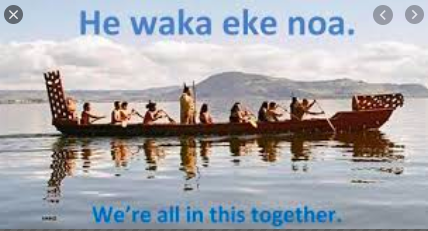
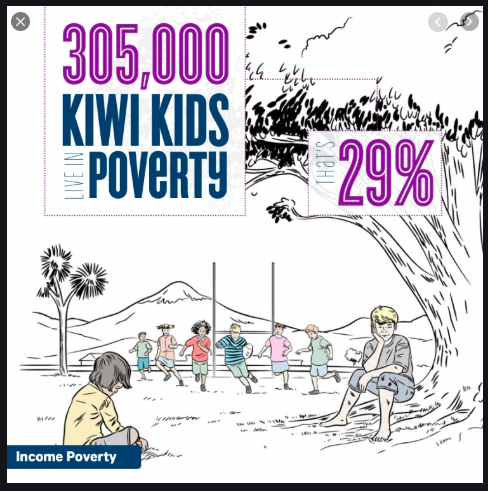
Context:
He Waka Eke Noa
Activities:
- Teacher discussion on the various social issues children/ youth are exposed to in New Zealand. See posters on child poverty and bullying. what are your views on this this. Do you think this problem occurs elsewhere in the world. What are the possible reasons why children are affected by
- Discussion in class about issues that effect the youth in our society today. Think of possible examples / impacts and consequences to these issues.
- See video on child poverty as well as bullying at schools.
- By working in groups of four think of one issue that is of concern to the youth today. Ideas can relate to school bullying, peer pressure, child poverty, social media abuse, etc.
- Step 1 create a visual plan on what you what to address and how to going to make a difference to get through this problem. This can be a map or a flow chart that alos uses important vocabulary and pictures. See example on the white board.
- Step 2: think of the medium which you will present your idea. Example video/ role play of chart/ website.
- Step 3: research your your idea in depth: definitions / location /statistics/ causes or reasons/ impacts onto the youth/ who supports (family/ school friends/ others)
- Step 5: create a survey based on this issue and interpret the results( extension lesson)
- Step 4; introduce effective yet realistic ways to stop/ reduce or resolve this issue
- present your ideas as a group in week 9
Learning Intentions: We are learning to (WALT)...
- To understand one social issue that effects the youth in our community today
- create awareness of this issue through role play/ video/ website
- Show ways to stop/reduce and resolve this problem.: Engage with step one and two for this week
Success Criteria: I can/have...
- Understood one idea/ social problem that effects the youth in our community
- Bring awareness and to stop/ reduce or resolve this issue.
- Engaged with step one and two for this wee
Resources:
statistics on problems affecting youth in New Zealand/ images/Homework:
PLAN & DO / WHAKAMAHI learning intentions:
- We are PLANNING... to create a story board on the treaty of Waitangi and connect this to the values we share as New Zealanders.
- planning to learn and develope our skills on teamwork/ friendship and collaboration.
- panning to present our understanding of of experiences at camp through a photography expression
- planning to demonstrate we can share ideas and work effectively well with others
-
Good Morning...students. For the next few weeks you will be involved with a group project, where you identify an issue and create change by making a difference.This will link with our context He Waka Eka Noa: how we work together to get through

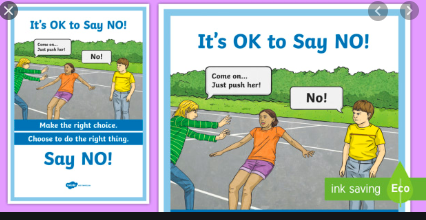
Context:
He Waka Eke Noa
Activities:
- Teacher discussion on the various social issues children/ youth are exposed to in New Zealand. See posters on child poverty and bullying. what are your views on this this. Do you think this problem occurs elsewhere in the world. What are the possible reasons why children are affected by
- Discussion in class about issues that effect the youth in our society today. Think of possible examples / impacts and consequences to these issues.
- See video on child poverty as well as bullying at schools.
- By working in groups of four think of one issue that is of concern to the youth today. Ideas can relate to school bullying, peer pressure, child poverty, social media abuse, etc.
- Step 1 create a visual plan on what you what to address and how to going to make a difference to get through this problem. This can be a map or a flow chart that alos uses important vocabulary and pictures. See example on the white board.
- Step 2: think of the medium which you will present your idea. Example video/ role play of chart/ website.
- Step 3: research your your idea in depth: definitions / location /statistics/ causes or reasons/ impacts onto the youth/ who supports (family/ school friends/ others)
- Step 5: create a survey based on this issue and interpret the results( extension lesson)
- Step 4; introduce effective yet realistic ways to stop/ reduce or resolve this issue
- present your ideas as a group in week 9
Learning Intentions: We are learning to (WALT)...
- To understand one social issue that effects the youth in our community today
- create awareness of this issue through role play/ video/ website
- Show ways to stop/reduce and resolve this problem.: Engage with step one and two for this week
Success Criteria: I can/have...
- Understood one idea/ social problem that effects the youth in our community
- Bring awareness and to stop/ reduce or resolve this issue.
- Engaged with step one and two for this wee
Resources:
statistics on problems affecting youth in New Zealand/ images/Homework:
-
Kia ora...Students. This week you will be Presenting your research on one social problem within our local or extended community in New Zealand and reflects good research.
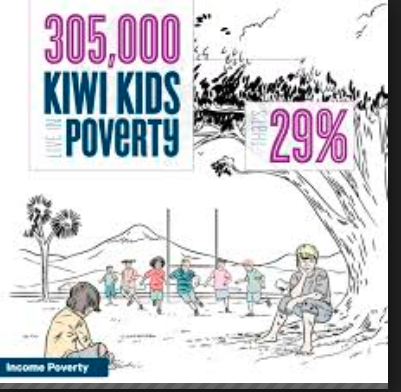
Big Idea: He Waka Eke Noa
Learning Intentions: We are learning to (WALT)...
- Understand good research techniques and work as part of a team.
- Understand and create an infographic
- Research your chosen idea in-depth using the template provided
- Created my chart through the principles of an infographic
Success Criteria: I can/have...
- Created an infographic that is interesting with good research
- Present my findings as part of a group in class.
Activities:
1. See video in class that highlights how presentations are done. Look for key strategies of taking a good introduction to capture your audience attention. Take turns to talk. Be calm and clear with your communication skills. Remember, I am here to support you/
Assessment: Project work: Step 1: Present your project: By working in a group of three, present your infographic of one social problem in our community eg: Child poverty/ child abuse/ bullying in schools: You are to create an infographic on this social issue. Your ideas will include the following: Title/ location with a map/ key definitions/ what id the cause of the problem with pictures and images/ the impacts of this problem/ some statistics/ comparison to another location either in NZ or Globally/ solutions to address this problem.
2.Step two: Answer questions from teacher and students
3Step 3: TAKE NOTE OF COMMENTS AND FEEDBACK. GOOD LUCK!!
Homework
REFLECT / WHAIWHAKAARO learning intentions:
- We are REFLECTING...on our research abilities/ creative designs of storyboards and team skills displayed at camp
- Reflecting on New Zealand and the social issues that effect youth in NZ and skills required to overcome these.
-
Reflections and Introduction to term 2 Context.

-
Kia ora...Students and Welcome to term 2. Our leaning will be online until we return to school. The focus is to ensure that everyone is well, safe and that you are using your time at home to develop skills that can be useful from your home environment. This is meant to be a fun yet creative and innovative few weeks for you.
Success Criteria: I can/have...
- created a new document Titled Global Studies term 2, where all my work will be documented.
- Explored my creative side of learning and created a fun game to share with my class when return to school.
- am innovative about the game choose to make, using materials from my home and outside.
- conscious of applying recycled materials to the design of my game.
Activities:
- Do now Activities( 20 Minutes): Everyday read the new Zealand Herald and write a short summary on one article of your choice. This summary should be about 6-7 lines and you should indicate at least two new words you have learnt. Write the meaning of these words before you write your summary.By the end of the week I expect you to have at least 3 summaries completed.
- From this week, you are to think, plan and create a game that is suited for children of all ages( adults too!). This game should be with the use of a cardboard box or shoe box/ maybe plastic bottle if you doe not have access to cardboard.
- Watch this video to give you some inspiration to design your game. Its about a young boy whom uses cardboard to design a game arcade! and he gains world fame for his innovative ideas. You can do it TOO.9.4M views8 years ago
I went to get my car fixed and met this 9 year old kid who built a cardboard arcade in his dad's auto shop. http://CainesArcade.com ... Subtitles - Instructions : This week you will Sketch a model of what your game would look like. Give your game a title. Write down instructions how to play the game.This can can be a board game, puzzle or idea from the image here,
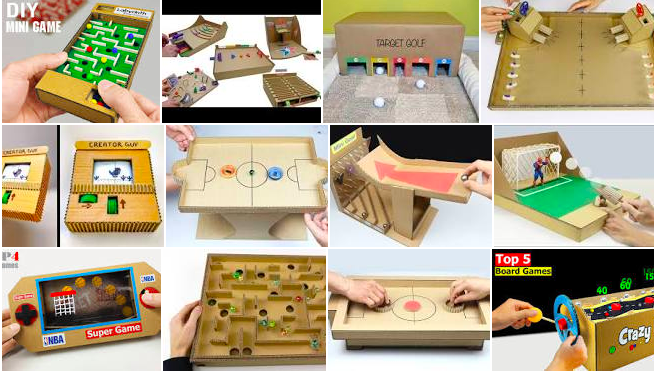
- Here are example of games form plastic bottle
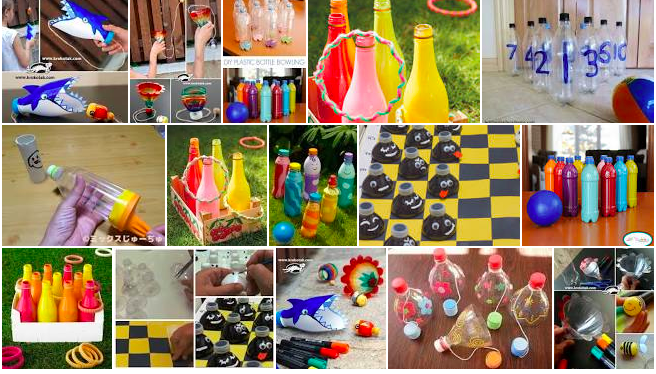
- You may use youtube to assist you selecting ideas or to support you with the step by step instructions of making your game.
- Next week you will design your game and have it completed to showcase for when you return to school.
- Let it be fun, interesting and creative but NOT complicated. Do not stress of you do not have materials, improvise your idea, your way.
- Remember you are required to create only one game.
Resources:
81K views6 years agoA cool board game for kids. Better storage ideas. Hope you like it! :D Twitter: @CrazyReveries My Shop: ... -
Kia ora...Students. I hope your online learning is going well. Remember to come online according to your Global Studies sessions, indicated in your time table.For this week you will complete creating you game made from either cardboard or plastic bottles. Awaiting to see your creative games, when we are bak at school.focus this week is to extend you creativity with new and different ideas such as planting, creating a toy or making a kite!
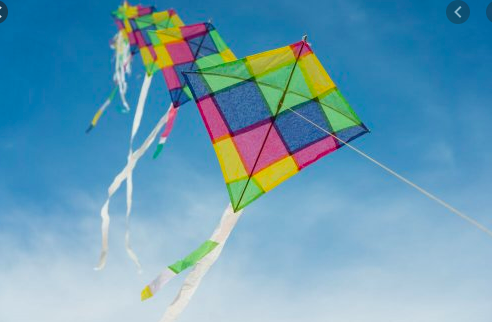
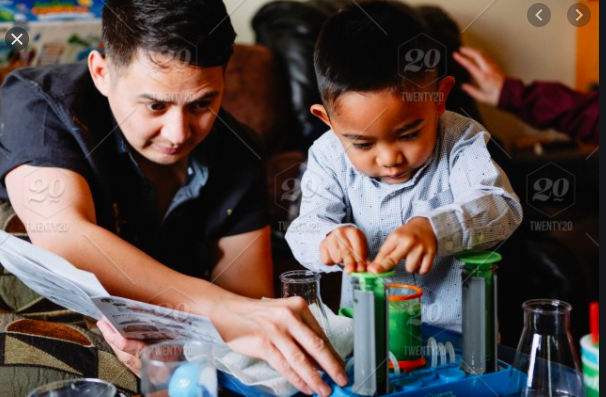
Success Criteria: I can/have...
- Completed my innovative game using cardboard, plastic or other recycled materials
- Read New Zealand Herald a made a summary of at least 3 articles per week.
- Started to think and do a new skill at home, that brings family together
Activities:
- For this week each day read one article from the New Zealand Herald and write a short summary of your chosen article, It should have a title, be at least 6 lines and use two new vocabulary.
- Please complete the design of your game by the end of this week. Take a picture to showcase in your google documents. Have a clear instructions sheet written, to indicate " how to play the game".
- For the remainder of this week you are encouraged to do something fun with your family. Im sure you are doing this any way. However, your task is to create a kite OR a planter box, or design a stuffed toy, with the support of your family members. The idea is to work, connect and explore together, thus having fun at the same time.
- For the design of the Kite, go onto the Nation Geographical Site: to find instructions. However, give it a personal touch whereby your kite show the identity and values of your family.
Together at Home | New Zealand Geographic
For the planter box, use a plastic container or if you already have a planter box, fill with soil/ compost. Add you favourite seeds. Take pictures of day 1 until day 8 , to show the growth of your plant/ vegetable. A good idea is to use beans/ tomatoes/ herbs to see rapid transformation from seed to plant within a week!!Enjoy.
Please document your work on google docs, with pictures of you playing your kite or tending to your garden/ planter box.
Homework/ Reources:
Nov 20, 2017 - Uploaded by wikiHowHow to Make a Kite. Kites are fun to make and fly outside on a nice, slightly windy day. Making a simple...Mar 12, 2018 - Uploaded by Mitre 10 New ZealandCheck out how to build your very own planter box at the Mitre 10 MEGA Easy As for Kids workshop.
Write here... -
Kia ora...students and welcome to week 3. Each year on the 25th Of April, New Zealand celebrates Anzac Day. This is both an important historical event as well as a day to commemorate the soldiers that had fought in the Gallipoli wars.
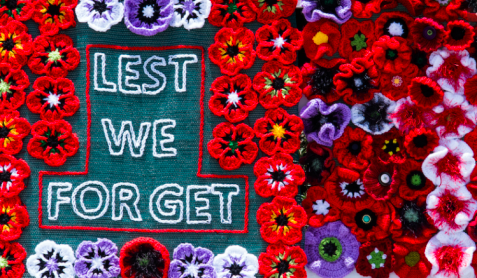
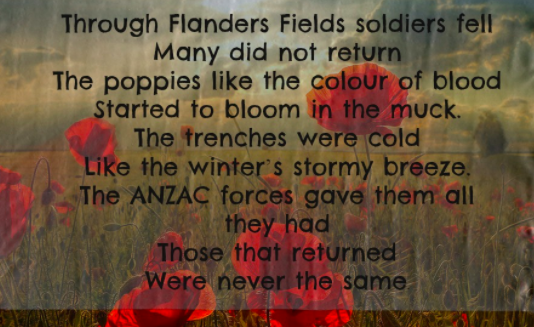
Learning Intentions: We are learning to (WALT)...
- Brainstorm vocabulary that link with Anzac Day
- Examine the history and meaning of Anzac Day
- To understand why is this important event celebrated in New Zealand and Australia
- Research the various past events in NZ that commemorates ANZAC day, including one in our community.
Success Criteria: I can/have...
- Researched and examine the history and significance of ANZAC DAY
Activities:
- Watch the video on the Gallipoli war and express you views on this historical event.Apr 12, 2017 - Uploaded by The Touring TeacherWe commemorate ANZAC Day every April 25th, but why is it important? ... Day? History for Kids ... TOP 10 ...
- Apr 28, 2015 - Uploaded by Behind the NewsThis was the landing at Gallipoli, on April 25, 1915, as described by ... Students will identify and discuss the ...
- Research the history of ANZAC DAY and create a powerpoint on the information you gather.Use the following template as a guide: Introduction/ reasons for soldiers from NZ and Australia supporting Britain/ Arrival into Gallipoli/ the war and aftermath/ your views.Write a short paragraph under each idea.
- Research news paper articles from this time that highlights the war. What key information did you discover
- Create a poppy and write a poem in dedication to the soldier that served New Zealand.( you have done this last term, perhaps some of you may want to copy your poem into your current document you are working with.
- Complete the ANZAC Day cross word finder in the folder
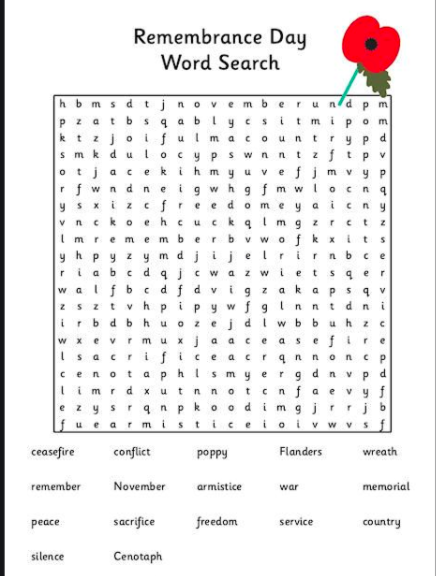
Resources:
Anzac Day - Anzac Day | NZHistory, New Zealand history online
https://nzhistory.govt.nz/war/anzac-day/introductionThe ceremony - Anzac Day | NZHistory, New Zealand history online
https://nzhistory.govt.nz/war/anzac-day/overviewNZ Army - Anzac Day
www.army.mil.nz › Culture & History- Write here
- Write here
Homework:
Write here... -
Kia ora...students. From this week we begin a new context titled The Earth Is Healing. Our planet has undergone serious changes due to both human activities and natural disasters. However, during the Covid 19 pandemic, where billions of people were forced into lockdown, our planet began to show signs of growth and cleansing. We will discover what are some of the problems that have led to environmental destruction before the pandemic and examine how some of these problems are reducing on earth. Furthermore, you will creatively and thoughtfully think of long term solutions to environmental protection that would benefit our future generations.
Success Criteria: I can/have...
- brainstorm the meaning of Our Earth Is Healing
- Discovered new vocabulary and definitions
- list the various environmental problems found globally before covid 19
- created a poster : testing prior knowledge on pollution reduction
- identified earth challenge app and log in data
Activities:
- Document all your work on google docs: What does the Earth is healing mean to you. Write at least 3 ideas. eg: Our planet is experiencing less human activity and therefore less pollution is produced.
- Think of ten ideas/ words that link with the earth is healing.Here are a few: pollution levels have declined/ less human activity/ greener grass/ cleaner air/ ozone hole/ traffic congestion reduced/ greenhouse gases/
- Discover the meaning of the following words: environment/ greenhouse effect/ global warming/ pollution/ natural resources/ exploitation/sustainable resources/.
- Examine the picture below and write 3 ideas on problems that occurred before covid 19 and how theses are improving.
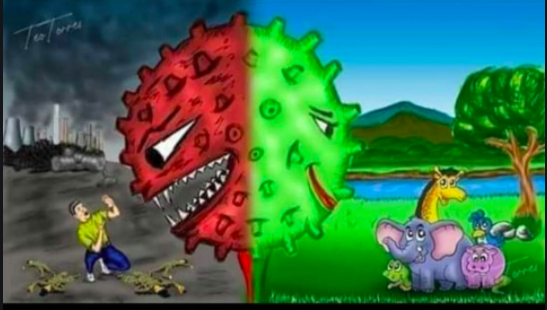
4)Why do you think people are responsible for the earths destruction ie pollution and global warming/ List 3 reasons.
5) Testing your prior knowledge: By referring to the problems such as ocean pollution, land pollution and, air pollution in crowed cities, create a poster to showcase how litter can be reduced in your home, before it reaches the landfill. Think of sustainable packaging and using recycled materials.Use Canva.com.
see this example:

6) Extension activity:refer to this link:
7 eco-friendly actions for kids during the pandemic | Earth Day
and download the earth challenge app. Here you log in air quality or plastic pollution in you local area. I suggest yo use you home/ immediate neighbourhood to discover information. Plot a daily log to show how much plastic you have found in your neighbourhood over a 5 day period.Discover if this is lessening in Alert 3, compared to Alert level 4 or increasing. Think of where the journey of a plastic bottle would go, if it does not reach a bin.Image of the app here:

7)What action can be taken in your neighbour to reduce and stop this problem
Homework/ Resources:
New Evidence Shows How COVID-19 Has Affected Global Air ...
COVID-19 Lockdown Illustrates Connection Between People ...
EXPLORE / TŪHURA learning intentions:
- We are EXPLORING...to observe how the Earth is healing through first hand witnessing of our neighbourhood, and researching ideas that showcases evidence
- We are EXPLORING...to experiment with the Earth Challenge app, so that I can record the amount of rubbish i see in my neighbour during lockdown and after lockdown.
- We are EXPLORING...to question why is the earth healing now compared to before lockdown
- We are EXPLORING..to discover new words and concepts based on Environmental sustainability
- We are EXPLORING..to recognise the influence human activities have onto resources on earth
-
Kia ora...students . From this week we aim to examine the causes to global warming, before Covid 19.In depth reading and research is required is required whereby you are referring to various readings, cartoons, posters and videos
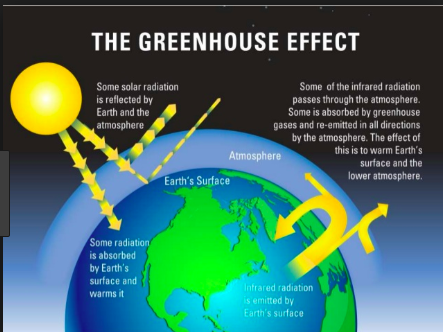
Achievement Objectives: Enter AO's here
Big Idea: The Earth is Healing
Learning Intentions: We are learning to (WALT)...
- research your chosen environmental issue using the checklist criteria
- research your ideas in depth
- construct sentences and paragraphs that are written in your own words and using new vocabulary
Success Criteria: I can/have...
- Successfully researched some ideas on my chosen environmental problem
- Constructed sentences and paragraphs that are well edited and have new vocabulary
Activities:
- Do Now activity: Read the article below on environmental problems in New ZealAnd. Discuss your thoughts on this as a class.What solution swill you suggest for this issue of Waste Runoff.
NZ's 'clean environment' under threat - NZ Herald
- Define what is meant by the following concepts. Shoe examples.Biodiversity, contaminate, ecology, homeostasis, conservation, sustainability.
- Understanding the greenhouse effect. Study this image and discuss your views on what is climate change.
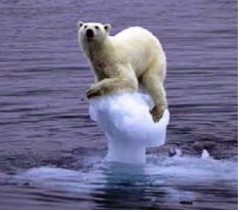
4. See video on what is climate change and how this has affected our planet.Discuss how climate change is caused.Write key words such as carbon emissions/ ozone layer/ CFCS/ ultra violet light/ and ice melting.
The Daily Conversation 1M views4 years agoA straightforward explanation of Climate Change: the heat from human emissions is roughly equal to exploding 400000 ... CC5.By working in your teams, begin to research your chosen environmental issue in the world. Create a word bank so that you are using new and important terminology for your research.
Homework
Write here...FOCUS / ARONGA learning intentions:
- We are FOCUSING...on developing our understanding on environmental sustainability
- We are FOCUSING...identifying the various ways mad kind has impacted onto destroying earths natural resources
- We are FOCUSING...describing acts of exploitation such as pollution that leads to Global warming, and plastic pollution
- We are focussing on discussing the impacts and consequences of these acts of environmental destructions
- We are focussing on responding to these problems by thinking of sustainable solutions
-
Kia ora...students . From this week we aim to examine the causes to global warming, before Covid 19.In depth reading and research is required is required whereby you are referring to various readings, cartoons, posters and videos

Big Idea: The EARTH IS HEALING
Learning Intentions: We are learning to (WALT)...
- Define key words linked with Environmental sustainability AND THE COVID 19 PANDEMIC
- Create a bank of ideas that link with environmental problems
- use a variation of resources so that information presented is diverse, unique and reflects good research and thinking
- Examine issues discussed as teaching examples in this eg: Climate Change
- Success Criteria: I can/have...
- Understood our Coast Whanau logo and will connect how our values links with the environmental issues we choose to research.
- Started to research my environmental topic in-depth
- Examined the controversies of climate change( debate)
Activities:
- Introduction to : what is Environmental Sustainability. Students may use coggle.com to create a word bank such as: Environment, pollution, exploitation, conservation, management, protection,
- Teacher example to environmental issues Do Now: Examine the cartoon on climate change: There are many controversial theories to climate change. What is your view and why.

- Draw a sketch on how you see earth in 100 years years from now. Does it reflect an ecological balanced environment, with clean technology in use or highly industrialised with earth elements out of sync. Explain your response.
- What is global warming. See images on the white board. Write a short paragraph on your ideas.
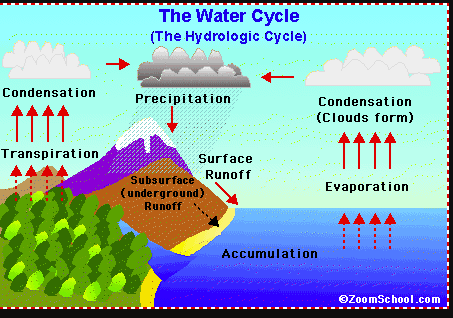
Activities:
- Research and paste a digram on the structure of the earth and indicate what are the different components.
- What us meant by magnetic field? examine the materials earth is made up of which is nickel iron. What do you understand by this material.
- Research and paste a diagram on earths atmosphere. List the different parts to the atmosphere and what gases may be found in each part.What is the purpose of the ozone layer?
- See video on earths atmosphere and list important vocabulary in your online document.
- Research and paste an image of the water cycle. Write a short paragraph on how the water cycle is formed.
- List with images the various clouds in earths atmosphere.
- What would happen to cloud formation if there was a drought?Explain with reasons.
- By testing your prior knowledge what id global warming. List important words by that link with this.
- Research and paste a diagram of what is global warming.
- What are greenhouse gas emission and what industries are likely to give these off.
- What is likely to happen if the co2 build up continues. How does this effect climate.
- Research one image of how climate change is effecting people and the environment. What would happen if this trend continues.
- Explain what is ozone depletion.
- Do you think climate change is causing sea level rise? How is this affecting our COASTS?
- See video on climate change and lets have aN ONLINE class discussion on this.
- By working in a team an infographic on your carbon footprint. Calculate the amount of gases and other materials you consume everyday that contributes to global warming.
Homework:
Write here...
- Define key words linked with Environmental sustainability AND THE COVID 19 PANDEMIC
FOCUS / ARONGA learning intentions:
- We are FOCUSING...on developing our understanding on environmental sustainability
- We are FOCUSING...identifying the various ways mad kind has impacted onto destroying earths natural resources
- We are FOCUSING...describing acts of exploitation such as pollution that leads to Global warming, and plastic pollution
- We are focussing on discussing the impacts and consequences of these acts of environmental destructions
- We are focussing on responding to these problems by thinking of sustainable solutions
-
Kia ora...This week we will examine how OUR OCEANS and coast lines are changing due to the influence of the Pacific Garbage Drift.
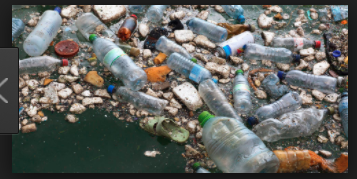
Achievement Objectives: Understand that events have causes and effects.Understand how formal and informal groups make decisions that impact on communities.
Big Idea: Our Earth is Healing
Learning Intentions: We are learning to (WALT)...
- determine what is the Pasific Garbage Drift and its history of origination
- Analyse the journey of plastic from factory to oceans:
- Examine what is consumer responsibility
- Examine the impacts of plastic pollution in the ocean
- Find possible solutions to reduce this problem.
Success Criteria: I can/have...
- Understood the cause and impacts of Pacific Pacific drift on oceans and coastlines.
Activities:
- Define what is Pacific Plastic Drift also known as the garbage patch of the pacific ocean. Research your answer.
- Provide a map to determine the location and size of the garbage patch.
- See images on white board of what this plastic drift looks like. How do you feel about this issue,
- Research when was the plastic drift first discovered and whom is responsible for this global pollution activity.
- Show a graph that highlights this problem . Discuss what the graph means.
- What impacts do you think plastic pollution creates to marine life/ oceans/air and coastlines. Discuss with images
- See picture of Indonesian man on kayak in the middle of plastic pollution in pacific. What do you think are the two possible reasons he is there!
- With a flow chart discuss the journey of plastic from factories to oceans. Discuss your views here as well.
- Provide ways in which plastic can be reduced and also ways of this not entering the ocean.
- Create a word bank with definitions that include: biodegradable/photodegradable/consumer awareness/ pollution/
Homework:
Write here...PLAN & DO / WHAKAMAHI learning intentions:
- We are PLANNING... to design a model or prototype that helps the environment, people and possibly the economy post Covid 19
- We are planning to consult with scientists. engineers or specialists about our innovation
- We are planning to collaborate with a team to produce an innovative design
- We are planning to solve one identified environmental problem that may continue to pick up or worsen post Covid 19
- We are planning to share our ideas to support the Science Fair held in Coast Whanau
-
Kia ora...students. For this week, you will research ways in which the oceans and coastlines and misused and exploited. You will learn about global examples and make links to the practices that occur in New Zealand.
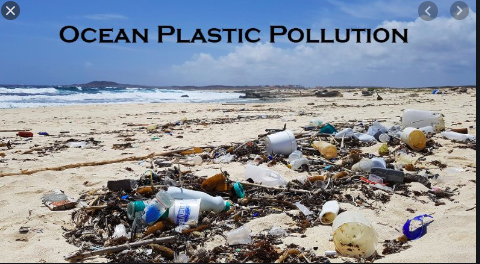
Success Criteria: I can/have...
- understood that our oceans and coastlines are not always protected and cared for due to exploitation of resources
- understood that pollution of all kinds damages our resources for future generations to have access to.
- researched that there are ways to reduce and resolve this misuse of oceans, through sustainable practices.
Activities:
- See the video on white board on pollution in oceans from around the world. What are your views of this problem. Explain through a flow-chart how you think plastic and other forms of pollutants enter the ocean. Is there a way to manage this problem?Discuss..Jun 17, 2018 - Uploaded by Global NewsBeaches throughout South East Asia are closing and whales are ... Plastic pollution crisis: How waste ends ...
- Show a map of popular beaches in New Zealand. List the various beaches you have been too. Are there any that you have visited been misused by people through pollution or activities that are illegal eg plastic on the shores or people overfishing. Express your views on these two problems ie pollution and overfishing?
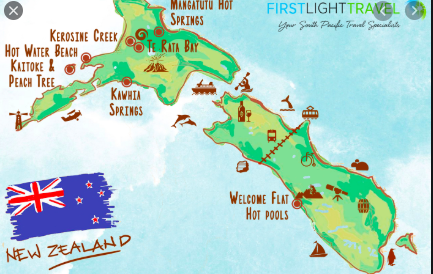
3) How do you think plastic pollution and over fishing affects both the environment and the economy. Write your ideas using a table and pictures to show the impacts. Eg plastic pollution effects marine life in various ways such as fish eating plastic and causing toxic contamination. With over fishing the supply of fish can reduce drastically and effect food chains and food webs.Think of 3 ideas each.
4) What would happen if pollutants continue to fill in our oceans? Think of both ocean life and life on the shores.
5) Define what is sustainability. Create a visual that shows ways in which we can have better practices at our oceans and beaches. Think of ideas that help support the resources found here remain clean, beautiful and available for future generations to come. Your ideas must include Sustainable practices from both people and the government.
6) Research who is GREENPEACE. Indicate ways in which they support to protect the ocean and marine resources in New Zealand.
RESOURCES:
Apr 2, 2017There are calls for a change to the way overfishing is monitored in NZ.Sep 26, 2018The country's biggest and most important fishery is in serious trouble. Skippers fishing in the West Coast hoki ...Plastic and rubbish ruining New Zealand beaches | Stuff.co.nz
Stop plastic pollution! | WWF New Zealand
The ocean plastic crisis - Greenpeace New Zealand
PLAN & DO / WHAKAMAHI learning intentions:
- We are PLANNING... to design a model or prototype that helps the environment, people and possibly the economy post Covid 19
- We are planning to consult with scientists. engineers or specialists about our innovation
- We are planning to collaborate with a team to produce an innovative design
- We are planning to solve one identified environmental problem that may continue to pick up or worsen post Covid 19
- We are planning to share our ideas to support the Science Fair held in Coast Whanau
-
Kia ora...Over the past 3 weeks we have examined environmental problems on earth, with reference to global warming and ocean pollution, Let us research the various ways in which the earth is healing as a result of the Covid 19 pandemic that allowed for the lockdown of over a billion people world wide.
Success Criteria: I can/have...
- understood why the lockdown was necessary( socially and environmentally)
- discover the various ways the earth began to heal
Activities:
- In your own words, write a summary on the benefits of the Covid 19 lockdown, had onto you, your community, nation and the planet.Think of the social benefits like family bonding.Then explore how natural resources began to flourish/ heal and regenerate in this time.
- Read this article, list your views:
Is The Coronavirus Lockdown Actually Healing The Planet ...
- Watch the videos below and create a slide show on the various ways the planet is healing.1) Global warming improving.2) Air pollution dropping3) River Water becoming cleaner 4)Wild animals exploring more of the earth. Show the various ways our earth is benefittig of the lockdown and how natural resources are improving/thriving. Choose at least 3 ideas to work on.
- Can the corona crisis help our planet to breathe again? ... I say its the beginning of a new world.... the world ...
- Scientists said there is one unexpected side-effect to the COVID-19 ... Your browser does not currently
- ...Satellite imagery show by Maxar technologies shows changes in movements and activities in cities due to ...Mar 19, 2020 - Uploaded by Geospatial World
- Vehicular emission and dust from construction sites have reduced helping India breather clean air. Watch the ...Apr 8, 2020 - Uploaded by Hindustan Times
- sika deer crosses road in Nara Japan, animal sightings as humans in ... Free-
roaming deer are a part of ... Apr 14, 2020 - Uploaded by Guardian News
Homework:
Write here... -
1) Fun Activity: we are creating an Ocean in the bottle. You will need a glass, clear water, sand, ocean decorations like fish/ sea weed shells and blue food colouring. Aim is to create a model that shows pristine beauty of oceans and the way it should look like- pollution free.
Follow instructions in link below:
Ocean in a Bottle : 5 Steps (with Pictures) - Instructables
See videos to support you:
Jan 8, 2016 - Uploaded by Dream GemThis miniature bottle charm is based off a children's science experiment that creates an ocean in a bottle just ...May 13, 2016 - Uploaded by What Do We Do All Day?How to make an ocean in a bottle. Fun science activity and sensory project for kids.Reflections and Introduction to term 2 Context.
-
Kia ora...students. For this week you will understand how to make your innovative product/ solution and begin creating, that addresses global warming or water pollution.

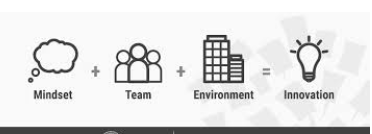
Achievement Objectives: Enter AO's here
Big Idea: The EARTH IS hEALING
Learning Intentions: We are learning to (WALT)...
- understand materials that are required and costs of these materials
- research ways to make our innovative solutions through youtube and reading sites like Wikihow
- research other similar products that have been created and find ways to make our product better/ more interesting yet realistic.
Success Criteria: I can/have...
- researched how to make our innovative solution and began designing this idea
- Think of ideas that have been influenced from the covid 19pandemic
Activities:
- Teacher example: Create air vents on windows that traps pollutants.
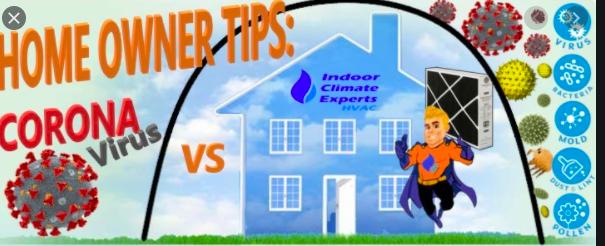
- Do Now: Watch videos on innovative solutions for the environment designed by kids. What are your views.https://www.youtube.com/watch?v=IGfiwFPJ6b4
- By working WITH AN EXPLORATIVE AND CURIOUS MIND, you must discover the materials that are required to make your innovative solution. Furthermore research the cost and where you will attain your materials from. You are encouraged to recycle used materials.
- Watch youtube clips on how to design your idea. Write down instructions with clear step by step procedures.
- tEACHER EXAMPLE:
- Begin designing your idea. Share the design equally as a team. You may go through trial and error to get the model perfected. These challenges are necessary to problem solve your way to achieve a positive outcome.
Resources:
Innovative solutions to environmental challenges | Stanford News
Global Shapers: 3 Hubs Create Innovative Environmental Solutions ...
https://www.coca-colacompany.com/.../global-shapers-3-hubs-create-innovative-envir..2012-06-20 Innovative Environmental Solutions Begins Construction ...
www.chinooksciences.com/innovative-environmental-solutions-begins-construction-o... -

Presentations of innovative solutions for the environment, post covid 19 pandemic.
Your ideas could be unique masks available for both human and animals to get through.
Air vents for industrial and domestic use that traps pollutants and possible viruses in the air from entering buildings
cleaner water intake through design of life straw.
WATCH THE VIDEO ON PRESENTAtION TIPS>
Each student/or team has 5 minutes to present their model.
Discussion will include:
Name of Model/ how did you design this/ what problem is it addressing/ why do you think this is an effective tool/ item/ strategy/ app/ or service.
Can people all around the world benefit from this including developing countries
Answer questions from the class.
REFLECT / WHAIWHAKAARO learning intentions:
- We are REFLECTING...on testing our prototype through PMI model
- We are Reflecting on the ethics applied to our design( social and environmental)
- We are reflecting on gaps we may have had during the research and creation process
- We are reflecting on generating ways to fill in those gaps
- WE are reflecting on the challenges and success we have experienced
- WE are reflecting on judging our innovation and the designs f others in our class thus allowing ourselves to think of the overall value and purpose of this activity
-
Kia ora...students and welcome to term 3. This term we have an exciting new Context : Innovations. For this idea we will research the way Ancient civilisations lived their lives and discover the many innovations that designed. We will also examine to see how these past innovations have changed and have purpose in our lives today.
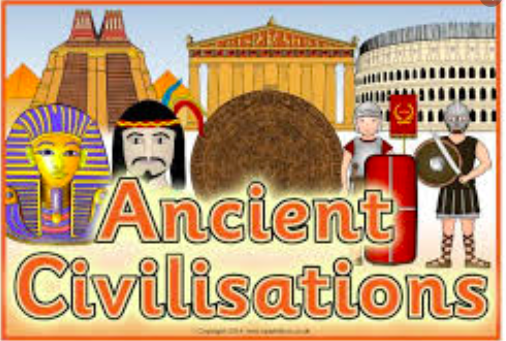
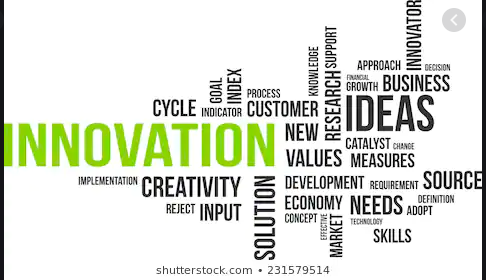
Success Criteria: I can/have...
- understood the meaning of Innovations
- connected the meaning of Innovations to to Ancient Civilisations
- discovered new words and multiple words that link with this idea
- Examined images from the past and and beginning to explored why people lived differently to us today.
Activities:
- What does innovation mean to you today. Give examples of products and technology that is useful to you. Eg the motor vehicle, boats, chairs and books to write in. Think for a moment: when do you think these products and technology was first innovated. Was it 10 years ago, 100 years or perhaps several thousand year ago?Give reasons for your response. class discussion on your ideas.
- I hope you have gathered that many products of today are linked to the ancient civilisations. Example: paper created by Ancient Egyptians using papyrus. Read this link:
Papyrus-Making in Egypt | Essay | The Metropolitan Museum ...
- By using coggle.com or a mind map or your choice, Lets create a brainstorm of words that link with Innovations eg: ideas, creativity, money, business, market and technology, as well as Ancient Cultures.Discussions on meaning of these words eg: invention, civilisation, trader, slave, merchant, irrigation, religion, cultures, class, caste, laws, wars, astronomy, maps.
- Examine the pictures on the white board on Ancient civilisations. table group discussions to identify landmarks linked to Ancient Cultures. Why were these amazing landmarks built. How where they built. Each table group research one landmark. Hopefully you would discover that it takes great skill to design these landmarks, as well that they all represent deep cultural importance.
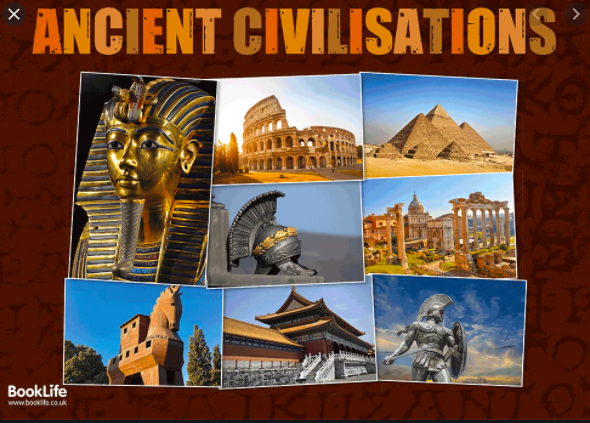
5) Have a look at the world map. Can you identify where these ( shown above )land marks are indicated.
6) Extension activity: Create a timeline of Ancient civilisations. See example here.
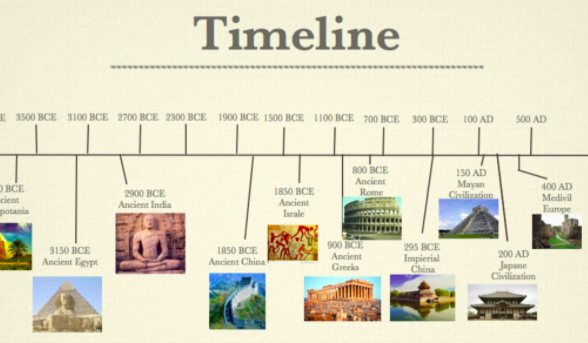
Resources:
What Exactly Is Innovation? - Forbes
Homework:
Write here...EXPLORE / TŪHURA learning intentions:
- We are EXPLORING...to investigate the meaning of innovations and how this idea links to ancient cultures
- We are EXPLORING...to discover the many concepts linked to Ancient Civilisations and innovation
- We are EXPLORING...to research the many cultural innovations from around the world, begining with Ancient Egypt
-
Kia ora...students and welcome to week 2! For this week we will explore ideas on the way of life Ancient civilisations such as the Egyptians. The Egyptians lived a very glamorous life, before wars that ended their reign. During this time, several items were innovated designed to improve their way of life. We will examine the location, culture and wars fought and how these impacted on people.
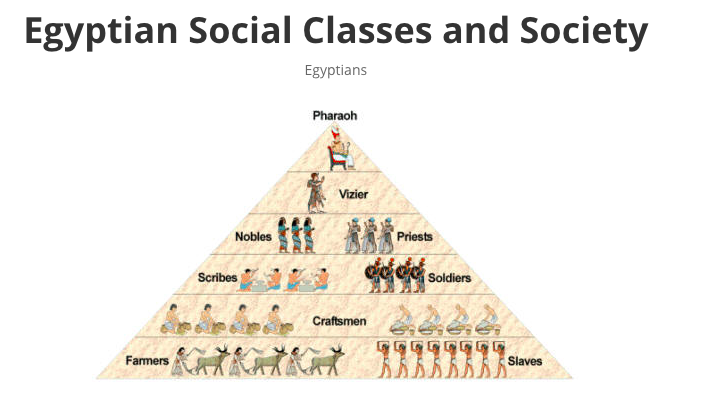
Achievement Objectives: Enter AO's here
Big Idea: Ancient civilisations
Learning Intentions: We are learning to (WALT)...
- to explore Egypt in terms of location( map work and distance from NZ)
- to understand the physical geography of Egypt ie land formations nature / climate in the past and today.
- to examine early cultural traditions in Egypt.
Success Criteria: I can/have...
- Examined the geography and began to explore the culture of early Egyptians.
Activities:
- Examine this ancient map of Egypt. What do you see as relevant an important features on tis map. Explain why.
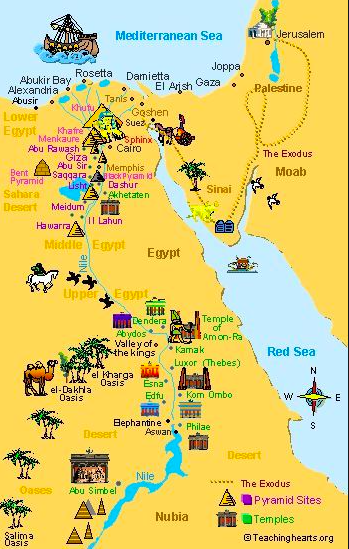
- Watch a video on the early Egyptians. Concentrate on the topography( landscape), cultural dress and way of life. Write down key ideas.... Richey gives a quick introduction to the geography of ancient Egypt, ... Your browser does not currently ...Oct 10, 2013 - Uploaded by Tom Richey
- The Ancient Egyptians culture was very unique in outlook and practice. By working in a team of 3,create a slide show on the the cultural identity of the early Egyptians in terms of dress, food, language, religion, arts, the class system, and land marks. Images will be displayed on the whiteboard, to prompt thinking.
- Few teams to share powerpoint to class.
- Each table group will have be given an image to research . Continue on your powerpoint: examine the image and research the importance of this tool/ science/ technology or ideaTable group 1: Pyramids / table two: Papyrus/ Table 3: the wheel. table 4: the calendar table 5 makeup and toothpaste.How was these designed/ what was its purpose/ do these still exist today/ has it been redeveloped.
- In this lesson, students will focus on learning about some of ancient Egypt's great queens - Nefertiti, Tiy, and Nefertari. Students will learn about what made these women powerful as well as how they influenced the lives of the common people by being held in such high regard by their husbands, the pharaohs.
- Research the clothing / jewellery and make up worn by the different classes or ranks. How does this compare to clothing and identity of early Maori people.
Resources:Ancient Egyptian Inventions - Discovering Ancient Egypt
https://discoveringegypt.com/ancient-egyptian-inventions/Ancient Egypt Technology and Inventions. | Fun Facts You Need to ...
ipfactly.com › ArticlesEgyptian Social Classes and Society - History
The social classes in ancient Egypt
www.reshafim.org.il/ad/egypt/people/social_classes.htm -
Kia ora...students and welcome to week 3! For this week we will explore ideas on the way of life Ancient civilisations such as the Egyptians. FOCUS this week is on innovations designed by the ancient Egyptians.
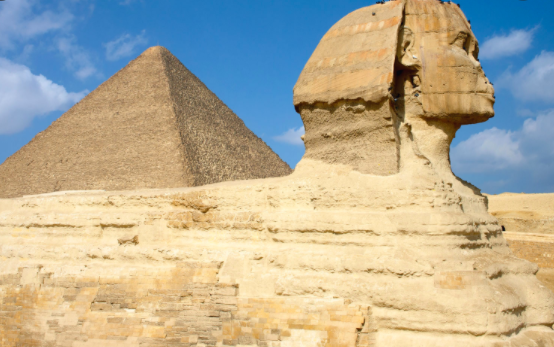
Achievement Objectives: Enter AO's here
Big Idea: Ancient civilisations
Learning Intentions: We are learning to (WALT)...
- to explore Egypt in terms of location( map work and distance from NZ)
- to understand the physical geography of Egypt ie land formations nature / climate in the past and today.
- to examine early cultural traditions in Egypt.
- Exploring and focusing on innovations from the Egyptians Ancient Era
Success Criteria: I can/have...
- Examined the geography and began to explore the culture of early Egyptians.
Activities:
- Examine this ancient map of Egypt. What do you see as relevant an important features on tis map. Explain why.

- Watch a video on the early Egyptians. Concentrate on the topography( landscape), cultural dress and way of life. Write down key ideas.... Richey gives a quick introduction to the geography of ancient Egypt, ... Your browser does not currently ...Oct 10, 2013 - Uploaded by Tom Richey
- The Ancient Egyptians culture was very unique in outlook and practice. By working in a team of 3,create a slide show on the the cultural identity of the early Egyptians in terms of dress, food, language, religion, arts, the class system, and land marks. Images will be displayed on the whiteboard, to prompt thinking.
- Few teams to share powerpoint to class.
- Each table group will have be given an image to research . Continue on your powerpoint: examine the image and research the importance of this tool/ science/ technology or ideaTable group 1: Pyramids / table two: Papyrus/ Table 3: the wheel. table 4: the calendar table 5 makeup and toothpaste.How was these designed/ what was its purpose/ do these still exist today/ has it been redeveloped.

- Video: watch and discussionsThe ancient Egyptians would come to invent mathematics, geometry, surveying, metallurgy, astronomy ...Apr 23, 2019 - Uploaded by TED-Ed
Resources:Ancient Egyptian Inventions - Discovering Ancient Egypt
https://discoveringegypt.com/ancient-egyptian-inventions/Ancient Egypt Technology and Inventions. | Fun Facts You Need to ...
ipfactly.com › ArticlesEgyptian Social Classes and Society - History
The social classes in ancient Egypt
www.reshafim.org.il/ad/egypt/people/social_classes.htm -
Kia ora...students. This week you will begin to explore and research ideas on ancient wars in Egypt.This was an important event,
as it provides insight into their cultural beliefs of creating pyramids and the journey of the after life.
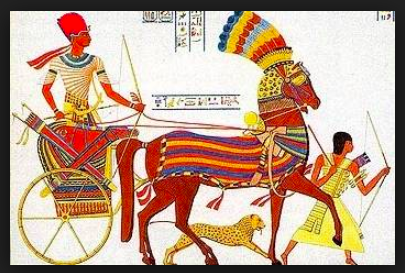
Achievement Objectives: Enter AO's here
Big Idea: Ancient Civilisations and Innovations
Learning Intentions: We are learning to (WALT)...
- Research one war in the ancient era in Egypt and the effects onto people
- Understanding reasons for war and whom they were fighting
- Examine Egyptian Gods and the mythology of life afterwards,
- Examine mummification and the scientific as well as cultural reasons for this.
Success Criteria: I can/have...
- researched one war in ancient Egypt and the effects onto people.
- Examined and understood the cultural and scientific reasons for mummification
Activities:
- Complete this puzzle:
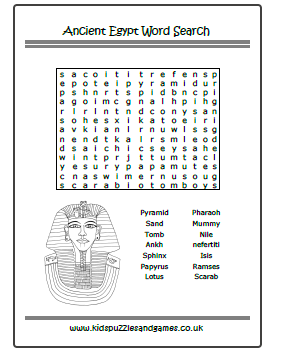
- List of wars you can choose from
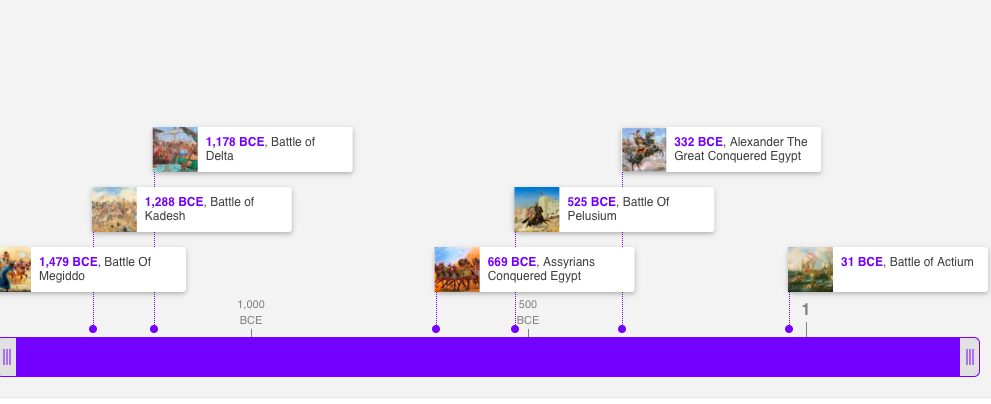
- Watch these videos as support to understand wars during this time.Mesopotamian culture was constantly changing and disrupted by war. Another reason we know so much ...Dec 2, 2012
- Ancient Egyptian warfare and weapons Support these videos on Patreon! :D https://www.patreon.com ...Jul 29, 2018 - Uploaded by Epimetheus
- By working in a team of four: choose one war in ancient Egypt that had a significant impact on the population during this time.Use the template below and create a slideshow:Era of war, location reasons for war, who fought during the war( classes and ranks)/ role of the King and Queens/ what where the effects of war onto the villages and kingdom as well as people./ why where pyramids built/ discuss what was done to the human body after wars.( mummification). Reasons for mummification.
- What are your views on the impacts of war on the Egyptians as well as their belief s on mummification.
Homework:
Write here...FOCUS / ARONGA learning intentions:
- We are FOCUSING...to develop our ideas as to why ancient civilisations innovations were important then and has purpose today
- We are FOCUSING...to research how these ideas were created, materials used and their functions in the ancient Era eg: papyrus, the wheel.
- We are FOCUSING...to determine what would our world be like without these innovations been made
-
Kia ora...Students. From this week you will work as a group where you will explore cultures from around the world and draw comparisons to Egyptian and Maori Cultures.The focus will be on traditions like tattoos, mummification, beatification , innovations designed by these ancient cultures.
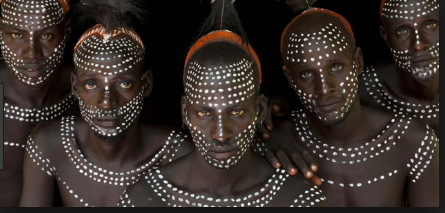
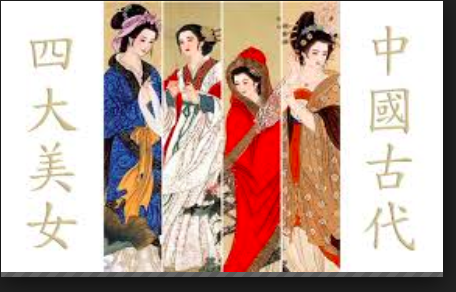

Achievement Objectives: Enter AO's here
Big Idea:Ancient Civilisations and Innovations
Learning Intentions: We are learning to (WALT)...
- research a new ancient civilisation and examine how they lived whereby there where changes to their bodies.
- Compare how this is similar or different to Ancient Egypt and Maori cultures
- document your ideas through a visual.
Success Criteria:
I have created a visual ( poster/ infographic or slideshow) based on how cultures from Ancient Eras have similarities and differences to Ancient Egypt and mOARI cultures
Activities:
- See video on ancient cultures with respect to tattoos, makeup, clothing and weapons used from your chosen culture and compared to Maori culture.
- Use and build on you a mind-map on vocabulary from the past such as : cultural identity/ traditions/ heritage/ ceremonies and image. Think of ancient concepts here.
- Refer to the image on white board on Ancient civilisations.Choose one culture for an example ancient Greece/ Indonesia/ China or India and research the following: Location, important ancient landmarks, cultural identity( clothing/ image/ religion) traditional practices eg marriages/ birth/ and what ceremonies to bodies when people pass on. Show art forms on their body eg: tattoos/ henna/ clay design. Compare at least two these with Ancient Egyptians and Maori Cultures.
- Create a visual to showcase all your ideas.
- Present to the class during week 8.
Homework
Complete you work, as this is due next week.
Resources:
The civilization of the ancient Greeks - TimeMaps
Ancient Greece - History, mythology, art, war, culture, society, and ...
https://www.timemaps.com › Encyclopediaancientgreece.com/ -
Kia ora...Students. Presentations due this on ancient cultures from around the world and draw comparisons to Egyptian and Maori Cultures.The focus will be on traditions like tattoos, mummification, beatification .
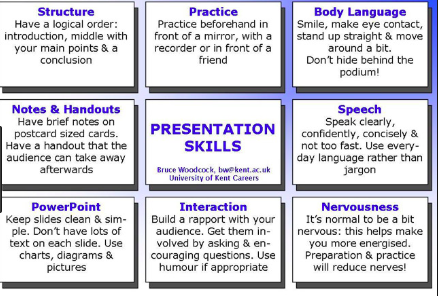
Achievement Objectives: Enter AO's here
Big Idea: Ancient Civilisations and Innovations
Learning Intentions: We are learning to (WALT)...
- research a new ancient civilisation and examine how they lived whereby there where changes to their bodies.
- Compare how this is similar or different to Ancient Egypt and Maori cultures
- document your ideas through a visual.
Success Criteria:
I have created a visual ( poster/ infographic or slideshow) based on how cultures from Ancient Eras have similarities and differences to Ancient Egypt andMoari cultures
Activities:
- Refer to the image on white board on Ancient civilisations.Choose one culture for an example ancient Greece/ Indonesia/ China or India and research the following: Location, important ancient landmarks, cultural identity( clothing/ image/ religion) traditional practices eg marriages/ birth/ and what ceremonies to bodies when people pass on. Innovations they designed that are useful today.Show art forms on their body eg: tattoos/ henna/ clay design. Compare at least two these with Ancient Egyptians and Maori Cultures.
- Edit your work/ Practice for presentation s that start this week.
- Create a visual to showcase all your ideas.
- Present all visuals to the class during this week.Remember to be calm/ confident and communicate clearly.Good Luck.
Homework
Complete you work, as this is due next week.
Resources:
-
Kia ora...students and welcome to week 9. For this week you will engage with a fun learning activity. ie to design a game on that links Ancient Civilisations
Success Criteria: I can/have...
- Created a plan that shows ideas on the game I wish to design. Your will also include your finalised idea of the game you wish to design
- Research the materials you require for your game design
- Research the instructions and you may tweak this to create your own instruction sheet.
Activities:
- Look at the white board that shows you how games were played in Ancient Eras.Long before monoloply was designed people were playing Senet in Ancient Egypt.
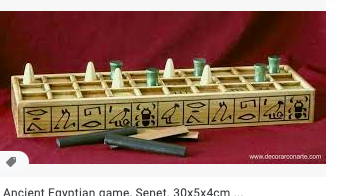
- Read this article to fin out more.
The Best Board Games of the Ancient World | Science ...
Watch these videos on ancient games... hopefully these would inspire you in the making of your own game.
This is a tutorial on how to make the ancient Roman board game called Ludus Latrunculorum. Also known as "The Game of ... What are you views on these Ancient games? Do you think they have value or would be enjoyed in todays modern world. Explain.
- Your task is to work in a table of 5 and create your own game. This can be a board game or card game. Maybe some teams want to explore design a game online( coding is required here!)You may design your game that is inspired from the Ancient civilisations s or create something new that links with the theme of Ancient Civilisations.
- Research your ideas, create a plan , bring all materials to school and begin designing. This should also include an instructions sheet.
Homework:
Write here... -
Kia ora...students and welcome to week 10. For this week you will complte and showcase the design of your game on that links Ancient Civilisations. This is alsoa reflection week of the terms learning.
Success Criteria: I can/have...
- Created a plan that shows ideas on the game I wish to design. Your will also include your finalised idea of the game you wish to design
- Research the materials you require for your game design
- Research the instructions and you may tweak this to create your own instruction sheet.
- Crete your game and complte to show to the class by the end of this week.
- Play your games with each other
Activities:
- Look at the white board that shows you how games were played in Ancient Eras.Long before monoloply was designed people were playing Senet in Ancient Egypt.

- Read this article to fin out more.
The Best Board Games of the Ancient World | Science ...
Watch these videos on ancient games... hopefully these would inspire you in the making of your own game.
This is a tutorial on how to make the ancient Roman board game called Ludus Latrunculorum. Also known as "The Game of ... What are you views on these Ancient games? Do you think they have value or would be enjoyed in todays modern world. Explain.
- Your task is to work in a table of 5 and create your own game. This can be a board game or card game. Maybe some teams want to explore design a game online( coding is required here!)You may design your game that is inspired from the Ancient civilisations s or create something new that links with the theme of Ancient Civilisations.
- Research your ideas, create a plan , bring all materials to school and begin designing. This should also include an instructions sheet.
- Create you game using recycled materials or materials from home.This is a team effort and each student should have an active role to play or create. Complete your game and showcase to the class. Enjoy playing as well!!
Homework:
Write here...REFLECT / WHAIWHAKAARO learning intentions:
- We are REFLECTING...on thinking of any gaps that were present in our learning such as research skills, communication skills for presentation.
- We are reflecting to think of the ethics that was used in ancient eras to create the innovations that they did.
- We are reflecting on concluding that ancient cultures have payed the way for the super innovations that exist today
-
Kia ora...students and welcome to term 4. I hope everyone had a great Spring vacation and you are well charged for our learning this term. Our context is on Planets and Beyond. Within this idea. you will virtually travel to countries that have earth quakes and volcanoes.Also , we will look into ideas about space and its wonders!
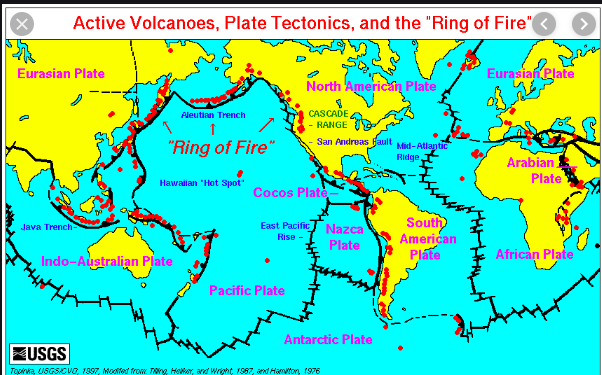
Achievement Objectives: Enter AO's here
Big Idea: Innovations( related to natural disasters earthquakes and Volcanoes)
Learning Intentions: We are learning to (WALT)...
- understand our new context through brainstorming ideas. Also examining prior knowledge on this topic.
- learn new concepts and definitions
- examine the world map and identify countries we know, as well as we have not heard off
Success Criteria: I can/have...
- brainstormed vocabulary that link with earthquakes and volcanoes to this idea
- researched the meaning of new concepts that link with earthquakes and volcanoes
- viewed the map of thew world with special links to countries that have earthquakes and volcanoes.
Activities:
- By examining the image of the world map on the white board list as many countries as you can that are prone to earthquakes and volcanoes. Why do you think these countries have these type of natural disasters.
- By using Mindmap such as coggle.us, brainstorm at least 10 words that link with around the world in earthquake /volcanic countries
- Find the definitions of the following concepts:l, natural disasters/ earthquakes/ volcanoes/ climate change/ tectonic plates/ ring of fire/ continental drift.
- Watch the video on continental drift. What are your views on the way continents have changed over time, are constantly changing.NEWER VERSION: https://www.youtube.com/watch?v=UgRHZ5jDPUU Watch 3.3 billion years of continental ...Apr 21, 2015 · Uploaded by Algol
- See agin the map of the world that have earthquakes and volcanoes. What are the requirements for New Zealanders to travel to two of these countries. With a buddy, research these requirements.
Homework:
Read on an article of an occurrence of an earthquake in New Zealand. -
Kia ora...students. For this activity you will be working in pairs. Your learning will explore the journey of a tourist to an earthquake zone country. You are required to document this activity in the form of a blog.This a a build up activity, where each week you will be given different questions/ instructions for you earthquake zone travel experience.

Achievement Objectives: Enter AO's here
Big Idea:Innovation
Learning Intentions: We are learning to (WALT)...
- Create a blog using blogger or any other you are familiar with.
- Research and chose one earth quake country of your choice, anywhere in the globe. Different countries for each pair.
- Read and examine the process for travelling to another country.
- Determine and understand the scientific process of an earthquake
Success Criteria: I can/have...
- created a blog.
- chosen one earthquake country that I will be exploring in good detail
- researched the scientific process of a earthquake and linked this to the country I am virtually travelling too.
- Understand the process and information required to travel to this country
Activities:
- By working in pairs you must first chose a blog site you will use for this this activity. Also through reading and discussions select an earthquake country you wish to examine.
- In detail explore what is an earthquake. How is it created and use images to show your discussions/research.
- Use the following template to document your research in your blog: Create a poster on how earthquakes are formed, the impacts and consequences it may bring. Also show a map of an earthquake country.
Homework:
Read further on earthquakes and how they are caused.Resources:
Blogger.com
Steps of earthquake formation - eSchooltoday
-
Kia ora...students and welcome to week 3. For this week you will be examining the impacts and consequences of earthquakes.
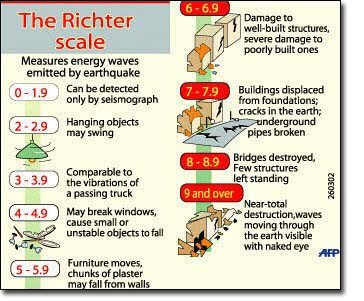
Achievement Objectives:
Big Idea: Innovations
Learning Intentions: We are learning to (WALT)...
- research the numerous impacts earthquakes have onto people/ the economy and the environment
- examine the consequences of earthquakes for that location and country
- use insightful images to demonstrate the impacts
- to discover and use new terminology
Success Criteria: I can/have...
- researched in detail the impacts and consequences of earthquakes onto people/ places and the economy.
- used images to show-case my discussions
- relate these impacts to my case study
Activities:
- see video on the impacts on earthquakes in Pakistan and Japan. Write down what you see and the effects this has at that time.
- Research the earthquakes that occurred in Christchurch 2011. Look for 2 newspaper articles on this event and write a short summary of this historical natural disaster.
- Through a case study approach: research the many impacts and consequences earthquakes onto people/ economy and the environment.Think of how people are affected/ the damage to the environment/ the costs to rebuild. How long does it take to have that location/ country continue with" business as usual..
- Link these impacts with your case study location. For this also include newspaper articles that shows the effects of the earthquake there.Update your blog by writing your findings here.
- Use words like richer scale, seismic waves, energy, warning signals magnitude, and
- Examine what are the potential consequences of an earthquake. Research ideas on landslides, tsunami, and liquefaction.What are these process and the effects it has as well.
- Research one cartoon that shows the impacts of the earthquakes. Provide an analysis of this in your blog.
ReSources:
BBC - GCSE Bitesize: Effects of an earthquake
Consequences of earthquakes (Fr) - Seismo at School
Homework:
Work on your survival kit -
Kia ora...students and welcome to week 4. Our focus this week is been prepared for an earthquake.

Achievement Objectives: Enter AO's here
Big Idea: Innovations
Learning Intentions: We are learning to (WALT)...
- Understand what does it involve to be prepared for an earthquake
- Determine are the laws and regulations in Nz to get through an earthquake
- determine get through strategies elsewhere in the world.
- understand what is a survival kit and its use during an earthquake.
- researching emergency contact details during an earthquake
- create plan what would you do if you where at home during an earthquake.
Success Criteria: I can/have...
- understood get through strategies both in New Zealand and elsewhere in the world in case of an earthquake.
- researched and understood what is a survival kit and its use
- researched important emergency numbers in nZ in case of an earthquake
- created a plan what to do if at home during an earthquake.
Activities:
- Watch video on earthquake in Christchurch, NZ, 2011. Reflect on what you see: before during and after the earthquake.
- Research how would you be prepared in the event of an earthquake in NZ. Research what the the get through strategies.
- Explain what is meant by drop cover hold.
- Research what are the get thorough strategies during an earthquake in two other countries in the world. how is this different to NZ.
- Explain what plan of action you would have to get through an earthquake if you were home.
- Research important emergency numbers to get help during and after and earthquake.
- Research what is a survival kit and the contents within it. How would you use each device/ item. What is its purpose.
- Draw what you would include in your personalised survival kit. Be imaginative here but also practical.
Resources:
Search Results
Earthquake - Get Ready Get Thru
Get Thru
New Zealand ShakeOut - Get Ready!
Earthquake: A guide to getting through the aftershocks | Stuff.co.nz
www.stuff.co.nz/.../nz-earthquake/.../earthquake-a-guide-to-getting-through-the-aftersho...Survival Kits | Emergency Preparedness Kit | Red Cross
Emergency Survival Items & Getaway Kit - Get Ready Get Thru
getthru.govt.nz/how-to-get-ready/emergency-survival-items/Homework:
Assessment: design creation and demonstration of your survival kits. -
Kia ora...students and welcome to week 5. This is an exciting week as you will demonstrate your survival kits.
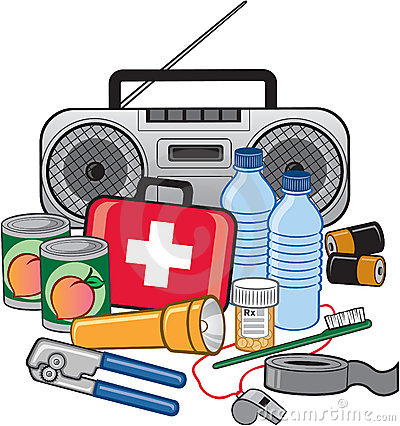
Achievement Objectives: Enter AO's here
Big Idea: Innovations
Learning Intentions: We are learning to (WALT)...
- examine what is a survival kit and why this is necessary if you live in an earthquake country
- create a survival kit where items are labelled
- demonstrate the use of each item with clarity
Success Criteria: I can/have...
- understood the value of a survival kit
- created a survival with each item labeled
- demonstrated its use with clarity and confidence
Activities:
- By watching the video on earthquakes, and the need for a survival kit, express what are your views.
- Complete the creation of your survival kit in class by making sure it is practical yet having a few unique items as well.Be creative and innovative.
- Each student is to demonstrate your survival kit, where you are assessed on the design and creativity, labeled items, clear demonstrations and reflections of the need for New Zealanders to keep a survival kit. Clear and good communication skills.
- Also, you are to create a slideshow to inform children in very poor countries what they can do to get through an earthquake using everyday items at home. This activity does require research but also for you to inference or use intelligent guesses.
Reources:
Emergency Survival Items & Getaway Kit - Get Ready Get Thru
getthru.govt.72 Hour Survival kits | Prepare
nz/how-to-get-ready/emergency-survival-items/Pack a Survival Kit
Homework:
Read on Volcanoes: science behind this natural occurance -
Kia ora...students. Our learning for this week is on Volcanoes
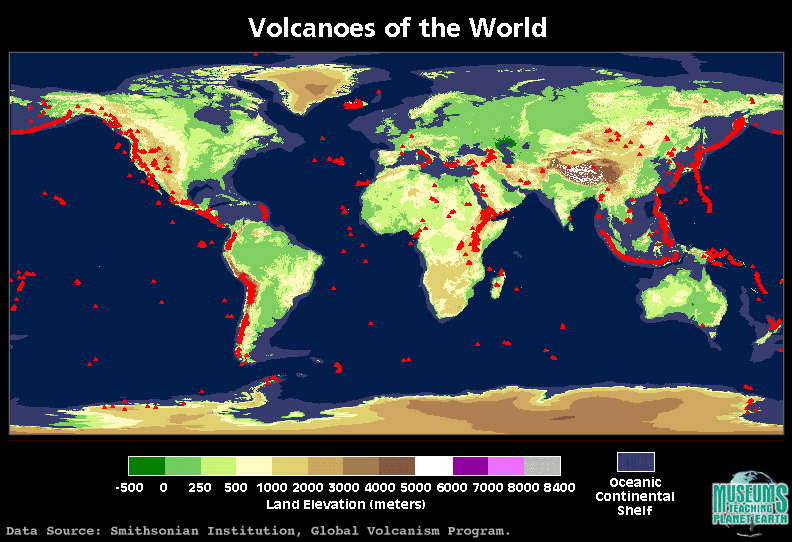
Achievement Objectives: Enter AO's here
Big Idea:Innovations
Learning Intentions: We are learning to (WALT)...
- examine what is a volcano and how it is formed
- discover countries that have both active and dormant volcanoes
- research a map of where volcanoes are located in NZ and Auckland.
- determine the history of activity of these volcanoes
- watch and analyse the science behind volcanoes, with examples form around the world.
Success Criteria: I can/have...
- understood where volcanos are located globally
- understood how they occur
- discovered the location on volcanoes in NZ and Auckland as well as its history of activity.
Activities:
- Write a brainstorm of words associated with volcanoes. Share with the class
- See world map. Where do you think volcanoes are found. Now see actual locations. Why do you think they are found around tectonic plates?
- Research and discover how volcanoes are formed. Draw a diagram to you paragraph discussions.
- Watch video on the science behind volcanoes
- Thorough map work, find out where in NZ are volcanoes found. Divide this into dormant and active.
- Now discover where in Auckland are volcanoes located. Research the history of activity of one volcano in Auckland.
- Design a poster that illustrates where volcanoes are found in NZ, indicating dormant or active.
Resources:
What Are Volcanoes? - Universe Today
What is a volcano? :: NASA Space Place
Homework:
Read on the impacts of volcanoes. -
Kia ora...students. Fo this week our focus is what are the impacts of Volcanoes onto people/ economy and the environment.
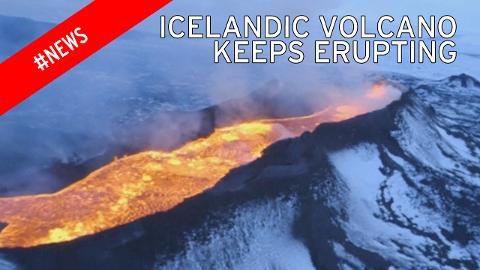
Achievement Objectives: Enter AO's here
Big Idea: Innovations
Learning Intentions: We are learning to (WALT)...
- discover the impacts and consequences of volcanoes
- interpret documentaries we see on volcanic eruptions and its impacts.
- create a visual that shows impacts and consequences.
Success Criteria: I can/have...
- researched and examined the impacts and consequences of earthquakes onto people/ the economy and the environment.
Activities:
- Watch the video on a volcanic eruption in Iceland. What are your views with this documentary. Do you think volcanic eruptions are promote tourism or lowers tourism? Explain your answer.
- Through research discover how volcanoes have an impact onto people/ the economy and the environment.
- Do you think there can be positive impacts as a result of a volcano. Explain your answer
- Imagine if a volcano erupts in North Island, that effects us here in Auckland. What will occur. Explain in detail. How will we get through to survive and carry on?Expalin
- Draw and create a virtual volcanic field trip. Use labels to show what we will see when a volcano erupts. Takes us through this trip with your image and labelling.You can have a footpath/ tracker path/ helicopter pads/ ect. See illustration on white board.
Homework:
Living under one of Iceland's most dangerous volcanoes, as it starts ...
FOUR of Iceland's volcanos are on the brink of erupting | Daily Mail ...
www.dailymail.co.uk/sciencetech/article.../FOUR-Iceland-s-volcanos-brink-erupting.htm...As tourism booms, Iceland waits for its next volcanic eruption | Toronto ...
How do volcanoes affect people? | Volcano World | Oregon State ...
Lesson 3: Effects of Volcanoes - Daniel Burke
danielburkedesign.com/sites/project_volcano/lesson3.html -
Kia ora...students. From this week you will be planning and designing how to make volcanoes. Information tags are also required for this activity.

Achievement Objectives: Enter AO's here
Big Idea: Innovations
Learning Intentions: We are learning to (WALT)...
- plan how to make a volcano model
- research the materials required
- design and create a volcanic model.
- create information tags.
- present our model to the class.
Success Criteria: I can/have...
- sketched out how a volcano model should look like
- researched the various materials I require to create on
- with my group begin creating a volcano
- design and produce information tags
Activities:
- Watch the videos on how to create a volcano. Think about he step by step process
- By working in teams of four, plan and label how yo would create your volcano.
- Research the many items and materials required for your design. try and be as unique and creative as you can. Think of the location of your volcano. It can resemble an actual one that exists.You amy use lights neo glow paints and other materials to make it look realistic.
- Begin creating your volcano with your team
- Each model requires labels and an information tag about your volcano: location/ active/dormant/ next predictive explosion/ tourism here
- Once your model is complete, present this to the class.
Homework:
collect materialsl required to make your volcano. -
Presentations of Volcanoes:
HOW DID YOU MAKE THIS MODEL
EXPLAIN HOW DOES IT WORK
DISCUSS LABLES
ANSWER QUESTIONS ON VOLCANOES GLOBALLY.
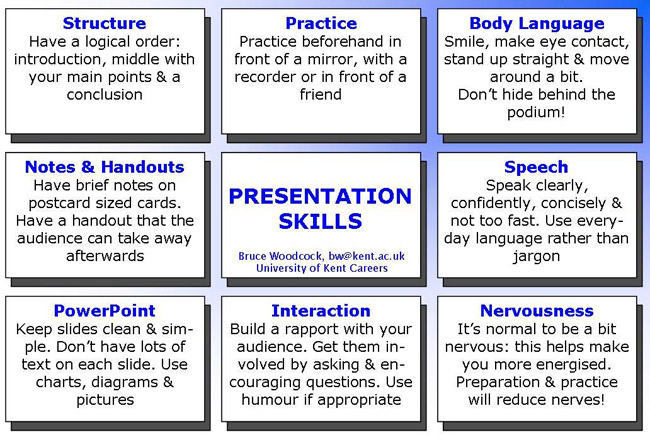
-
Reflection of term 4 work using the Positive/ Challenges and changes table.
